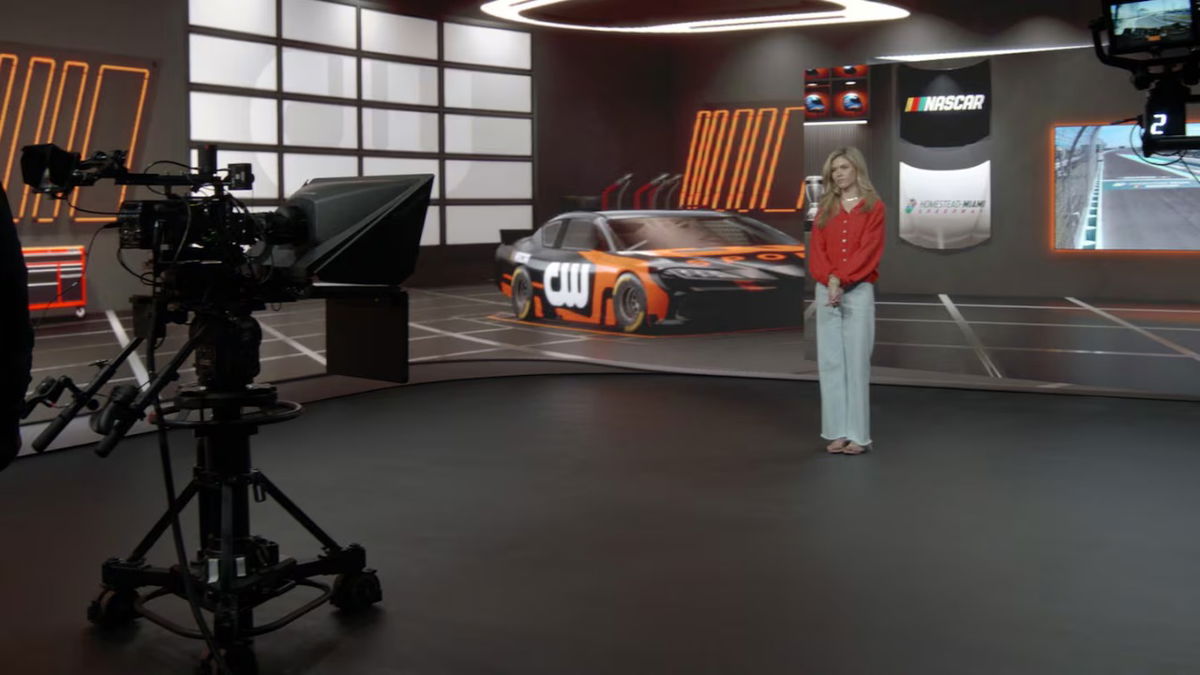
Imago
CW Studio

Imago
CW Studio
The CW Network shook up NASCAR Xfinity coverage in March, when it called select races from its North Carolina studio instead of being on-site, a major shift from the trackside broadcasts fans are used to. The reason? A high-tech approach to modernize coverage and enhance the viewing experience. At least, that was the plan.
Watch What’s Trending Now!
The new format split the broadcast into two. From their state-of-the-art studio in Charlotte, Adam Alexander, Jamie McMurray, and Parker Kligerman called the race from their watching monitors, far from the roar of engines and the rhythm of the track. On-site, only the pit reporters were present, tasked with delivering updates straight from the garages and pit lane.
Viewers at home saw quick cut-ins to the reporters on location, but the bulk of the commentary came from the studio team surrounded by screens rather than asphalt. It was an unusual sight for fans used to seeing the full broadcast crew perched above the start-finish line, with the track buzzing just outside their window.
ADVERTISEMENT
The turning point came when NASCAR Xfinity Racing tweeted: “What does everyone think of @TheCW_Sports trying out a new #XfinitySeries practice coverage format?” The post quickly drew attention, exposing the network to immediate scrutiny. Viewers raised concerns about technical glitches, from blurry video feeds to audio interruptions, as well as extended commercial breaks.
The setup itself was designed to balance innovation and practicality, but the rollout highlighted the challenges of keeping fans engaged. Local affiliate hiccups, like Peachtree TV accidentally cutting to a baseball game during a race, only added to the tension.
What does everyone think of the @TheCW_Sports trying out a new #XfinitySeries practice coverage format? pic.twitter.com/2qSyesa7Zh
— Xfinity Racing (@XfinityRacing) September 27, 2025
ADVERTISEMENT
For The CW, the experiment has been a learning moment. The network acknowledged the issues and said it plans to refine the approach for future races. While the goal of modernizing coverage is clear, this rollout demonstrates how crucial it is to maintain the connection between the broadcast booth, the track, and the audience. For now, the debate over remote coverage is far from over. Fans have been very vocal about their distaste for this experiment.
ADVERTISEMENT
Fans don’t hold back on NASCAR Xfinity’s query
The first wave of criticism came from viewers who felt the studio-heavy approach distracted from the real action. They pointed out that fans tune in primarily to watch cars on the track, not broadcasters on a soundstage. As one user put it, “CW’s done a ton of things right this year, but this isn’t it. Showing way too much of them with the stuff we actually want to see just sitting there on screens in the background.” The frustration here was evident in the balance. They were clearly unhappy that the booth got more screen time than the racing.
Another fan doubled down on this point, but also raised the issue of sponsor visibility. Their response was clear. “Not a fan. If there’s data to show, then show us. Otherwise we want to see the cars on the track, not a floating camera showing the on-air talent talking. I’m sure the team’s sponsors also prefer to be shown on the track.” For NASCAR teams and sponsors, being seen during the broadcast is vital. This comment highlighted how the coverage decision could have ripple effects beyond just viewer enjoyment.
While some fans were appreciative of The CW’s efforts, they were firm in their opposition to the format. One wrote, “Absolutely not a fan. I really like your coverage but so much this in studio version. Cover track action. Your great team can talk in the background like usual!” This reaction clarified the tension between liking the broadcast crew and disliking the method. Fans don’t want to lose the commentary. But they do want it layered naturally over track footage, as opposed to in place of it.
ADVERTISEMENT
Other fans took a different stance. They acknowledged the appeal of the studio itself but still drew a line when it came to the broadcast priorities. One fan admitted, “That studio is amazing but I want to see the cars in full screen. Like these guys a lot & all their feedback is informative.” The key here was simple. The setup was not the problem, but the execution certainly was. Even if the facility looks impressive and the announcers are engaging, race fans ultimately expect the cars to dominate the screen.
Finally, one comment touched on the larger context of sports broadcasting after the pandemic. A viewer remarked, “I like it but the announcers should be at the track this isn’t 2020.” This was a pointed reminder that remote coverage had become a necessity during COVID. But other than that, there was no reason to shift back to remote. Fans today see little reason to continue it.
All in all, there wasn’t much confusion on the stance. The reactions paint a consistent picture united in its approach. Fans may like the broadcast team and even appreciate the studio setup, but more importantly, they feel the experiment pulled attention away from what matters most: the racing itself. The CW now faces the challenge of striking a balance between innovation and authenticity if it hopes to win over its NASCAR audience.
ADVERTISEMENT
ADVERTISEMENT
ADVERTISEMENT
ADVERTISEMENT

